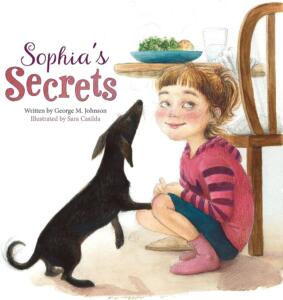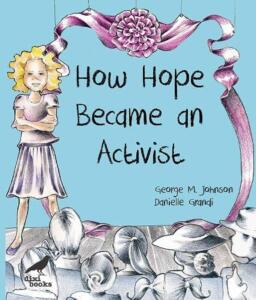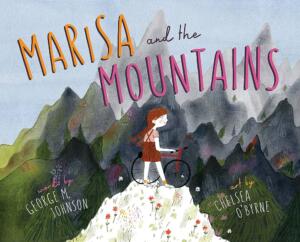1867 ‘Altogether lovely’ books for kids
Sophia’s Secrets
By George M. Johnson (illustrated by Sara Casilda)
New York: Clavis Publishing, 2023
$28.50 / 9781605376103
How Hope Became An Activist
By George M. Johnson (illustrated by Danielle Grandi)
London, UK: Dixi Books, 2020
$19.99 / 9781913680008
Marisa and the Mountains
By George M. Johnson (illustrated by Chelsea O’Byrne)
Vancouver: Simply Read Books, 2020
$21.95 / 9781927018910
Reviewed by Alison Acheson
*
 George M. Johnson, screenwriter, playwright, and professor of English at Thompson Rivers University, has now published three picturebooks for younger readers.
George M. Johnson, screenwriter, playwright, and professor of English at Thompson Rivers University, has now published three picturebooks for younger readers.
His most recent, the 2023 title Sophia’s Secrets, is a delightful book about… secrets! The funny thing about secrets is that somehow they end up being shared.
Take a moment to appreciate the endpapers: these are lovely, with ladybugs with opened wings, flying—so different from how we usually see them in story books. Ladybugs flying always momentarily alarmed me as a child. Then they surprised me; those wings hidden under the spots always seemed to be a secret in itself. And the dedication in this book gives some indication of the genesis of the story, in which Johnson thanks his daughter for sharing her world. The world of children’s secrets is quite sacred to my mind, and this book brings that to life.
In our current clime of safe spaces, the story opens with words about taking care of a “big secret” via sharing with parents or an aunt. I like the way that Johnson has handled this; it really slips by unnoticed—unless it needs to be. It’s right there off the top. On that opening page too is the idea that some little secrets can simply be kept in one’s heart and not shared. So, the extremes of the “secret spectrum” are right there, and after that the story can open out and go places.

And it does: Sophia shares secrets with her dog—sometimes the secret IS the secret! In this case, true. Sometimes she shares with real friends and with make-believe ones. She sometimes whispers to the wind. The understated in this story is all the ways we release things from our selves in healthy and imaginative ways. There are times we need to puzzle through human action and choice—and climbing a tree can be an excellent way to do that.
This story connects meaningfully with the nature of the inner level of play—when children appear to be packing a sandcastle or digging a hole, perhaps they are working out frustration or anger, or replenishing their mind and heart with stamina and understanding. And it serves as affirmation for young reader-listeners that their play and exploration is exactly as should be; that “message” is something they cannot hear too often.
The illustrations are calming and rich with quiet details, with double-spreads and spot bits (ah! that striped dress truly is an ugly thing, worthy of its end!) And the white space is appropriate for the movement of Sophia’s world. At 24 pages, it’s a shorter read—perfect for the tired parent at the end of a day. An altogether lovely book.
 How Hope Became an Activist was a finalist for the Eric Hoffer Book Award. Published in 2020 by a UK independent press, it’s a roadmap to how to become caring and active in our world, beginning with the label in one’s shirt: where was it made? It’s that close to home.
How Hope Became an Activist was a finalist for the Eric Hoffer Book Award. Published in 2020 by a UK independent press, it’s a roadmap to how to become caring and active in our world, beginning with the label in one’s shirt: where was it made? It’s that close to home.
From there, a conversation opens between a parent and daughter. Mom points out that the children who made the shirt are probably the age of the main character, and while we might feel a need to protect children from some realities, when a child somewhere in our world is experiencing injustice, there’s an argument for others of the same age to know it. Adult knowledge of the child with whom they are reading is key; so often a book is the best way to meet a subject. The visuals—unlike television and video—are more manageable, as is the message and when shared, it’s more likely to cause discussion.
Johnson writes with care. At times the dialogue feels a bit old for “picturebook” audience, but this is an illustrated book rather than a picturebook, and intended for slightly older readers, and/or for classroom material.
What is the difference? A picturebook relies heavily on its illustration to tell its story. It can’t be read without the visuals. An illustrated book, on the other hand, can be read with visuals that merely “back up” the words. This illustrated book is informative, and the words can be read on their own. The visuals might further explain the thoughts, and might draw in a more diverse readership in terms of literacy; we are now so image-dependent.
The main character is taking part in a stage play about injustice, and this is a solid device to open dialogue about what can and can’t be said. She speaks to wanting to shout out at another actor, and can’t; the stage play mirrors life in a useful way. Even the character’s anxiety about performing becomes a useful path to trying to understand the lives of others. And in this, Johnson speaks to the arts role in justice, and the developing of empathy.
After parental guidance with the first action these young characters take, they come up with an idea for their own activism. The thought that young people can do real and positive actions to make the world a better place for others—for other young people, in particular—is strong and well-done.
This is a significant book for library shelves and schools especially.
 Marisa and the Mountains, Johnson’s third work for this age, is a beautiful picturebook, and I wish I could say more. But in good conscience, I cannot promote the work of this publisher. If you are curious, I leave it to you to go online and discover.
Marisa and the Mountains, Johnson’s third work for this age, is a beautiful picturebook, and I wish I could say more. But in good conscience, I cannot promote the work of this publisher. If you are curious, I leave it to you to go online and discover.
*

Alison Acheson is the author of almost a dozen books for all ages, with the most recent being a memoir of caregiving: Dance Me to the End: Ten Months and Ten Days with ALS (TouchWood, 2019). She writes a newsletter on Substack, The Unschool for Writers, and lives on the East Side of Vancouver. Editor’s note: Alison Acheson has also reviewed books by Janice Lynn Mather, Jacqueline Firkins, Barbara Nickel, and Caroline Adderson for The British Columbia Review, and Dance Me to the End: Ten Months and Ten Days with ALS was reviewed by Lee Reid.
*
The British Columbia Review
Interim Editors, 2023-24: Trevor Marc Hughes (non-fiction), Brett Josef Grubisic (fiction)
Publisher: Richard Mackie
Formerly The Ormsby Review, The British Columbia Review is an on-line book review and journal service for BC writers and readers. The Advisory Board now consists of Jean Barman, Wade Davis, Robin Fisher, Barry Gough, Hugh Johnston, Kathy Mezei, Patricia Roy, Maria Tippett, and Graeme Wynn. Provincial Government Patron (since September 2018): Creative BC. Honorary Patron: Yosef Wosk. Scholarly Patron: SFU Graduate Liberal Studies. The British Columbia Review was founded in 2016 by Richard Mackie and Alan Twigg.
“Only connect.” – E.M. Forster
2 comments on “1867 ‘Altogether lovely’ books for kids”